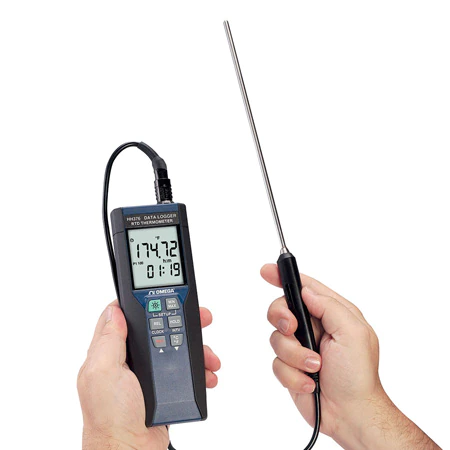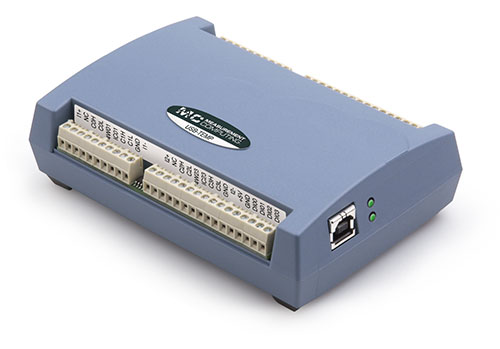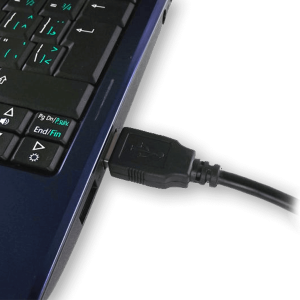Data logger or data acquisition system: What is the difference?
Context
You have a factor to measure, for example, temperature. There are several types of precision sensors that require a converter to render temperature data. However, the data displayed in your project is insufficient; you want to keep track of it. Your next question is:
How do I record environmental data?
Whether we are talking about a data logger or a data acquisition system, there are four main components to consider:
- the number of channels* needed for your project
- the number of devices to record all the desired parameters
- the recording capacity
- the ease of access to your data.
*Channel: continuous reading of a measurement parameter
The data logger: a compact tool
The data logger is a compact and portable all-in-one tool. Whether you have only one parameter to measure or several, you will find a sensor that meets your needs. Here are the main features of a data logger.
Characteristic |
|
| Number of channels | Maximum 32 (1) |
| Number of devices | Stand-alone; difficult to combine |
| Type of power supply | Often battery powered, sometimes wired |
| Maximum number of recorded data | Limited by internal memory and sampling rate |
| Recording media | Internal to the recorder, limited capacity |
| Data access | Transfer from internal memory to computer |
| Sampling rate | Typically max 1 reading/second (1 Hz) |
In the previous table, note that data loggers are often battery-operated due to their portable nature. For example, Omega presents a portable data logger that runs on a 9V battery and measures temperature with a Pt100 RTD probe.

Also, to allow for a longer sampling time, notice in the table that the sampling rate is limited. This is because the internal memory has a limited capacity. Typically, a data logger is used for a period ranging from 1 to 30 days. Finally, in order to collect the recorded data, it is necessary to extract them from the internal memory and transfer them to a computer for further analysis.
Data loggers can be equipped with an LCD screen to facilitate data visualization in real-time, as in the illustration presented above. However, very few have a mechanism for viewing historical and current data. The visualization option is useful if you want to see the effects of a change on the measured parameters at a glance. For example, if you open the door of an incubator and want to see the effect on the stability of the temperature, humidity and carbon dioxide (CO2) level.
The above scenario raises another important point to consider. Data loggers are individual instruments. They provide time-stamped measurements, but if you have several different instruments measuring all your parameters of interest (temperature, humidity, and CO2), you will have to harmonize the data from all the instruments manually. Before buying a data logger, consider the future: will you need a complete system to measure other parameters? If so, think about the data acquisition system.
The data acquisition system: a powerful tool
Some companies will tell you that data acquisition systems (DAQ systems) can be expensive. This may be the case if you need a high-powered computer connected to the sensors. However, some DAQ systems work with a desktop computer and give you more data acquisition capability than data loggers.
Characteristic |
|
| Number of channels | Maximum 100 or more |
| Number of devices | Several |
| Type of power supply | Wired |
| Maximum number of recorded data | Almost unlimited |
| Recording media | Computer or external SSD drive (2) |
| Data access | Immediately |
| Sampling rate | Max 10 readings/second (10 Hz) or more |
In the table above, notice that the data acquisition system has much greater capabilities than the data logger. Note the much faster sampling rate and immediate access to the data.
Sometimes DAQ systems seem complicated, such as the one from MCC, which allows you to connect different temperature probes (thermocouple, RTD, thermistor) and access the raw voltage reading. It should also be noted that this solution does not allow you to obtain measurements of different types.

Dracal Technologies' offer
The USB DAQ system proposed by Dracal Technologies is so simple that we named it "Plug & Log Solution". USB port connects the sensors to a desktop computer, and the very intuitive graphical interface software allows you to literally plug and log your data in less than 3 minutes.
When you choose Dracal Technologies, you get free access to software tools to view and record your sensor data. DracalView is a graphical user interface that you can install on your Windows, MacOS or Linux computer. Easy to use, it allows you to configure, according to your standards, the recording of your measurements. You will also find a sampling frequency of up to 10 Hz and time-stamped data. With its graphical visualization options, you can see in real-time the data you are recording and the data measured since the sensor was connected. If you want to learn more about DracalView, check out our short video tutorials here.
With our data acquisition system, you will also have command line tools to extract data directly from the sensors. You can use them to integrate the data into your existing measurement system. They are an equivalent alternative to the software since they allow the same configuration options as DracalView, but without using the graphical interface to record the data.
The system proposed by Dracal Technologies allows connecting a virtually unlimited number of USB sensors. The only limit is imposed by the computer's memory to which they are connected. Moreover, all measurements will be harmonized, regardless of their type (pressure, temperature, humidity, gas, particles, VOC or ambient light). This means that all measurements will be taken at the same time, at the same frequency, the units will be the same, and the logging alignment of each sensor will be simple, accurate and automatic.
In conclusion
When you want to record environmental data, two types of devices are available to you: data loggers and data acquisition systems. The major difference between the two lies in four main features:
- the number of channels needed for your project
- the number of devices to record all the desired parameters
- the recording capacity
- the ease of access to your data.
The data acquisition system outperforms the data logger on all four counts. With virtually unlimited recording capacity and a huge number of channels, your environmental data is recorded directly to your computer for immediate access. It also allows you to connect multiple identical or different sensors and obtain harmonized data. Dracal Technologies' solution is to harmonize the data from an unlimited number of sensors, regardless of their type, to have a consistent and scalable data acquisition system.
The data logger is portable and often runs on batteries. For seamless and continuous recording, a wired system is preferable. With Dracal Technologies, the sensors are powered by a USB connection. This connection also allows reliable transmission of the measured data to the computer where they are recorded.

Finally, if you want to consult in real-time and in a graphical way the measurements you make, in addition to the past measurements, you need a data acquisition system with this feature. This is what Dracal Technologies offers you, that is, a USB DAQ system, composed uniquely of its USB sensors and software package.
Contact us to see how we can meet your precision environmental data acquisition needs.
References
- Smith, Grant Maloy. 2020. “What Is a Data Logger - the Ultimate Guide | Dewesoft.” Dewesoft.com. April 3, 2020. https://dewesoft.com/daq/what-is-data-logger.
- Smith, Grant Maloy. 2022. “Data Acquisition (DAQ) - the Ultimate Guide | Dewesoft.” Dewesoft.com. June 28, 2022. https://dewesoft.com/daq/what-is-data-acquisition.